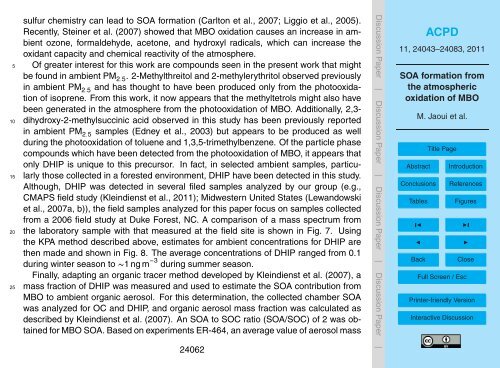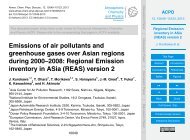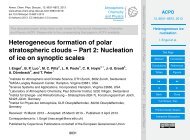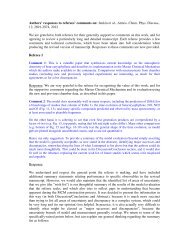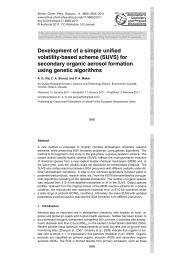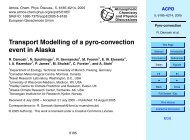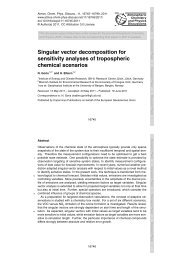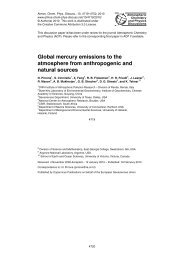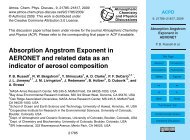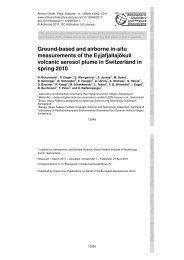SOA formation from the atmospheric oxidation of MBO - ACPD
SOA formation from the atmospheric oxidation of MBO - ACPD
SOA formation from the atmospheric oxidation of MBO - ACPD
Create successful ePaper yourself
Turn your PDF publications into a flip-book with our unique Google optimized e-Paper software.
5<br />
10<br />
15<br />
20<br />
25<br />
sulfur chemistry can lead to <strong>SOA</strong> <strong>formation</strong> (Carlton et al., 2007; Liggio et al., 2005).<br />
Recently, Steiner et al. (2007) showed that <strong>MBO</strong> <strong>oxidation</strong> causes an increase in ambient<br />
ozone, formaldehyde, acetone, and hydroxyl radicals, which can increase <strong>the</strong><br />
oxidant capacity and chemical reactivity <strong>of</strong> <strong>the</strong> atmosphere.<br />
Of greater interest for this work are compounds seen in <strong>the</strong> present work that might<br />
be found in ambient PM 2.5 . 2-Methylthreitol and 2-methylerythritol observed previously<br />
in ambient PM 2.5 and has thought to have been produced only <strong>from</strong> <strong>the</strong> photo<strong>oxidation</strong><br />
<strong>of</strong> isoprene. From this work, it now appears that <strong>the</strong> methyltetrols might also have<br />
been generated in <strong>the</strong> atmosphere <strong>from</strong> <strong>the</strong> photo<strong>oxidation</strong> <strong>of</strong> <strong>MBO</strong>. Additionally, 2,3-<br />
dihydroxy-2-methylsuccinic acid observed in this study has been previously reported<br />
in ambient PM 2.5 samples (Edney et al., 2003) but appears to be produced as well<br />
during <strong>the</strong> photo<strong>oxidation</strong> <strong>of</strong> toluene and 1,3,5-trimethylbenzene. Of <strong>the</strong> particle phase<br />
compounds which have been detected <strong>from</strong> <strong>the</strong> photo<strong>oxidation</strong> <strong>of</strong> <strong>MBO</strong>, it appears that<br />
only DHIP is unique to this precursor. In fact, in selected ambient samples, particu-<br />
larly those collected in a forested environment, DHIP have been detected in this study.<br />
Although, DHIP was detected in several filed samples analyzed by our group (e.g.,<br />
CMAPS field study (Kleindienst et al., 2011); Midwestern United States (Lewandowski<br />
et al., 2007a, b)), <strong>the</strong> field samples analyzed for this paper focus on samples collected<br />
<strong>from</strong> a 2006 field study at Duke Forest, NC. A comparison <strong>of</strong> a mass spectrum <strong>from</strong><br />
<strong>the</strong> laboratory sample with that measured at <strong>the</strong> field site is shown in Fig. 7. Using<br />
<strong>the</strong> KPA method described above, estimates for ambient concentrations for DHIP are<br />
<strong>the</strong>n made and shown in Fig. 8. The average concentrations <strong>of</strong> DHIP ranged <strong>from</strong> 0.1<br />
during winter season to ∼1 ng m −3 during summer season.<br />
Finally, adapting an organic tracer method developed by Kleindienst et al. (2007), a<br />
mass fraction <strong>of</strong> DHIP was measured and used to estimate <strong>the</strong> <strong>SOA</strong> contribution <strong>from</strong><br />
<strong>MBO</strong> to ambient organic aerosol. For this determination, <strong>the</strong> collected chamber <strong>SOA</strong><br />
was analyzed for OC and DHIP, and organic aerosol mass fraction was calculated as<br />
described by Kleindienst et al. (2007). An <strong>SOA</strong> to SOC ratio (<strong>SOA</strong>/SOC) <strong>of</strong> 2 was obtained<br />
for <strong>MBO</strong> <strong>SOA</strong>. Based on experiments ER-464, an average value <strong>of</strong> aerosol mass<br />
24062<br />
Discussion Paper | Discussion Paper | Discussion Paper | Discussion Paper |<br />
<strong>ACPD</strong><br />
11, 24043–24083, 2011<br />
<strong>SOA</strong> <strong>formation</strong> <strong>from</strong><br />
<strong>the</strong> <strong>atmospheric</strong><br />
<strong>oxidation</strong> <strong>of</strong> <strong>MBO</strong><br />
M. Jaoui et al.<br />
Title Page<br />
Abstract Introduction<br />
Conclusions References<br />
Tables Figures<br />
◭ ◮<br />
◭ ◮<br />
Back Close<br />
Full Screen / Esc<br />
Printer-friendly Version<br />
Interactive Discussion


